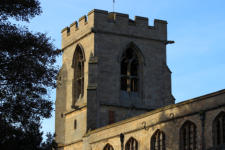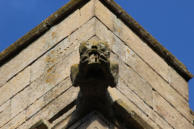
Guide to St Leodegar
Welcome to our church!
You may be surprised that the church seems to be on the wrong
side of the main A16 road but you are, however, in both the
geographical and historical centre of the parish of Wyberton.
The Domesday survey lists Wyberton as having a church in
1086. Nothing further is known about that building but the
one that you see today had its origins in the 13th century.
This church is one of only four English churches dedicated to the
French saint, Leodegar.
Although some of that original church remains, the remainder of
the body of the church dates from the 15th century with a
Georgian apse in place of a chancel. We now invite you to make
your way around the interior of the church and have identified
some of the main items of interest. Its history is surprisingly well
documented.
If you start at position (1) you are standing under the centre of the
tower in that C13 church.
That was the central tower in a church that was of cruciform
shape, with transepts and chapels and a long chancel. In 1419 the
Rector, John Stokes, found that the tower had collapsed together
with most of the nave, leaving only the chancel almost intact.
Now turn towards the altar and look at the gigantic pillars (2).
These pillars together with the large archway are part of that C13
church. Note how the pillars lean outwards as they would have
been supporting the weight of that tower. Walk a few paces down
the nave and you can see on either side the bases of two more
gigantic pillars, marked (3) on the plan. Together these make it
possible to envisage the scale of that early tower and crossing.
Although this is all that remains standing of that C13 church, the
fallen masonry was reused to build a new church; essentially the
one you are now standing inside. Looking first at the pillars along
the nave, those on the north side are built from reused curved
stone columns (4) whereas along the south are hexagonal (5). At
the west end of the church is the tower, under which you entered
this church building. Again this is all constructed by using the stone
from that original church. Around the walls of the nave and aisles
there is occasional evidence of C13 stone trefoil frieze set into the
walls. The history of this rebuilding is recorded owing to legal
proceedings at the
Chancery Court
relating to the
payment of the
London stone-
mason engaged for
the purpose.
Looking up at the
roof of the nave you
are seeing oak
timbers that have
been in place since
C15. This is one of
the finest features of this church. It has moulded tie beams with
wooden angels and corbels – all part of that original C15 roof. The
tracery of the windows in the aisles and the clerestory are also
C15; most have Victorian glazing.
Return to the east end of the church. In 1760 the rector, Dr John
Shaw found that the pillars of the chancel were leaning alarmingly.
Fearful of another collapse, he obtained permission to demolish
the large chancel and in its place erect a smaller structure, the
Georgian brick-built apse that we see today, constructed at the
same time as the nearby Rectory, now called Wyberton Park, was
re-fronted.
For many years the three windows in this apse were blocked up,
but in 1973 the interior of the church was transformed by
reinstatement of glazing in the two side windows.
A bequest enabled purchase of sections of the east window of St
James’ Church in Boston, at the time of its demolition. The simple
figures depict St James and St Guthlac on the left (6) and St Hugh
and St Botolph on the right (7).
Above the altar, between the two windows a late C18 reredos (8)
contains the text of the Ten Commandments and the Our Father.
Another clue to the history of this church is in the changed
floor levels where there are steps down into the nave and up
into the sanctuary. These result from decisions first during the
C15 rebuilding to raise the floor level – possibly to strengthen
the foundations – but then to lower it again during the C19
when underpinning was required to stop the side aisles from
collapsing. It was during this latter work that the extent of the
original C13 church building was revealed, along with the piers
of those earlier pillars (3) by the lectern and pulpit. This
restoration was carried out under instruction of architect,
George Gilbert Scott. The pews would have been removed at
this time. Side doors and porches, thought to be unsightly,
were also removed. Evidence of one of them is visible from
outside the building on the south side. The pulpit dated 1881
is dedicated to the rector, Rev Charles Moore who died before
completion of the work.
The
church
has
two
fonts.
One
is
a
C14
century
bowl
(9)
that
is
no
longer
in
use
owing
to
the
fragility
of
its
stonework.
A
C15
font,
(10),
on
a
tall
base
is
currently
used
for
baptisms.
This
was obtained from a
redundant church in Norwich.
Other
items
that
you
may
like
to
note
inside
this
building
are
listed below:
In
the
north
aisle,
on
a
window
ledge,
are
two
interesting
stone
corbel
heads
(11)
that
were
recovered
from
the
churchyard in 1956 by the gravedigger.
These
were
later
dated
as
being
of
the
Norman
period
so
may
be all that remains of the church mentioned
in
the
Domesday
Book.
Nearby
on
the
wall
is
a
charities
board
(12) dated 1794 with painted text.
On
the
floor
of
this
aisle
is
an
incised
C14
slab
(13)
depicting
Adam de Frampton and his wife Sybill. This is
made of black Tournai marble but, sadly, is much worn.
In
the
tower
the
belfry
contains
three
C17
bells.
It
can
be
accessed if required through the narrow stairway
(14)
but
permission
must
be
sought
from
the
Churchwardens
or
rector.
The
framework
of
the
bells
is
not
strong
enough
for
them to be properly rung now.
The
newest
structural
addition
to
this
building
was
the
creation
of
a
screen
(15)
at
the
time
of
the
recent
millennium
with interior doors to enhance the entrance into the church.
(If you are visiting…)
Please
finish
your
time
by
walking
around
the
outside
of
the
church
building.
Such
a
simple
building
viewed
from
the
exterior
gives
few
clues
to
its
surprising
history
but
there
is
evidence
of
the
many
alterations
if
you
look
carefully.
At
the
same
time
look
at
some
of
the
interesting
inscriptions
on
gravestones and enjoy the tranquillity of this rural churchyard.
Anyone
visiting
in
spring
can
appreciate
the
profusion
of
wild
primroses.
The
newest
part
of
the
burial
ground
is
in
the
walled
garden
to
the
east
of
the
car
park
area.
Feel
free
to
walk in there.
Alison Austin 2017
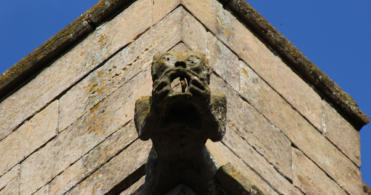
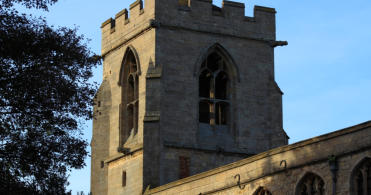
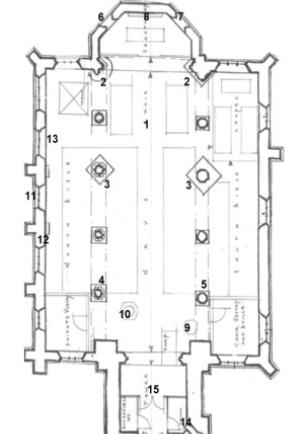
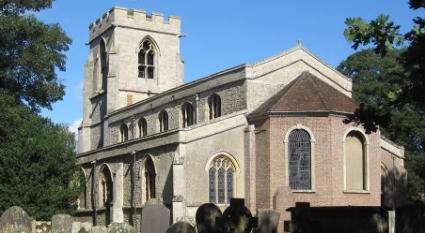
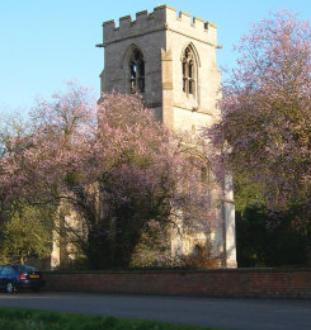


Wyberton Guide

© The Churches
in Wyberton &
Frampton
Site Editor:
John Marshall
Guide to St Leodegar
Welcome to our church!
You may be surprised that the church seems to be
on the wrong side of the main A16 road but you are,
however, in both the geographical and historical
centre of the parish of Wyberton.
The Domesday survey lists Wyberton as having a
church in 1086. Nothing further is known about
that building but the one that you see today had
its origins in the 13th century.
This church is one of only four English churches
dedicated to the French saint, Leodegar. Although
some of that original church remains, the remainder
of the body of the church dates from the 15th
century with a Georgian apse in place of a chancel.
We now invite you to make your way around the
interior of the church and have identified some of
the main items of
interest. Its history is
surprisingly well
documented.
If you start at position
(1) you are standing
under the centre of the
tower in that C13
church.
That was the central
tower in a church that
was of cruciform shape,
with transepts and
chapels and a long
chancel. In 1419 the Rector, John Stokes, found that
the tower had collapsed together with most of the
nave, leaving only the chancel almost intact. Now
turn towards the altar and look at the gigantic pillars
(2). These pillars together with the large archway are
part of that C13 church. Note how the pillars lean
outwards as they would have been supporting
the weight of that tower. Walk a few paces down the
nave and you can see on either side the bases of
two more gigantic pillars, marked (3) on the plan.
Together these make it possible to envisage the
scale of that early tower and crossing. Although this
is all that remains standing of that C13 church, the
fallen masonry was reused to build a new church;
essentially the one you are now standing inside.
Looking first at the pillars along the nave,
those on the north side are built from reused curved
stone columns (4) whereas along the south are
hexagonal (5). At the west end of the church is the
tower, under which you entered this church building.
Again this is all constructed by using the stone from
that original church. Around the walls of the nave
and aisles there is occasional
evidence of C13 stone trefoil frieze set into the walls.
The history of this
rebuilding is recorded
owing to legal
proceedings at the
Chancery Court
relating to the
payment of the
London stone-mason
engaged for
the purpose. Looking
up at the roof of the
nave you are seeing oak timbers that have been in
place since C15. This is one of the finest features of
this church. It has moulded tie beams with wooden
angels and corbels – all part of that original C15 roof.
The tracery of the windows in the aisles and the
clerestory are also C15; most have Victorian glazing.
Return to the east end of the church. In 1760 the
rector, Dr John Shaw found that the pillars of the
chancel were leaning alarmingly. Fearful of another
collapse, he obtained permission to demolish the
large chancel
and in its place erect a smaller structure, the
Georgian brick-built apse that we see today,
constructed at the same time as the nearby Rectory,
now called Wyberton Park, was re-fronted. For many
years the three windows in this apse were blocked
up, but in 1973 the interior of the church was
transformed by reinstatement of glazing in the two
side windows.
A bequest enabled purchase of sections of the east
window of St James’ Church in Boston, at the time of
its demolition. The simple figures depict St James
and St Guthlac on the left (6) and St Hugh and St
Botolph on the right (7). Above the altar, between
the two windows a late C18 reredos (8) contains the
text of the Ten Commandments and the Our Father.
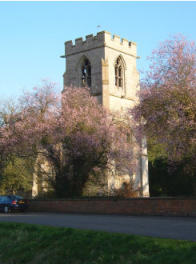
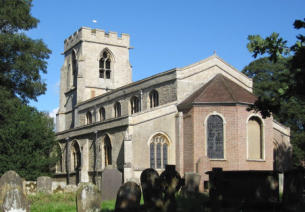
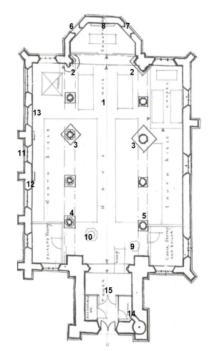
Another clue to the history of this church is in the
changed floor levels where there are steps down
into the nave and up into the sanctuary. These result
from decisions first during the C15 rebuilding to
raise the floor level – possibly to strengthen the
foundations – but then to lower it again during the
C19 when underpinning was required to stop the
side aisles from collapsing. It was during this latter
work that the extent of the original C13 church
building was revealed, along with the piers of those
earlier pillars (3) by the lectern and pulpit. This
restoration was carried out under instruction of
architect, George Gilbert Scott. The pews would have
been removed at this time. Side doors and porches,
thought to be unsightly, were also removed.
Evidence of one of them is visible from outside the
building on the south side. The pulpit dated 1881 is
dedicated to the rector, Rev Charles Moore who died
before completion of the work.
The
church
has
two
fonts.
One
is
a
C14
century
bowl
(9)
that
is
no
longer
in
use
owing
to
the
fragility
of
its
stonework.
A
C15
font,
(10),
on
a
tall
base
is
currently
used
for
baptisms.
This
was
obtained
from
a redundant church in Norwich.
Other
items
that
you
may
like
to
note
inside
this
building are listed below:
In
the
north
aisle,
on
a
window
ledge,
are
two
interesting
stone
corbel
heads
(11)
that
were
recovered
from
the
churchyard
in
1956
by
the
gravedigger.
These
were
later
dated
as
being
of
the
Norman
period
so
may
be
all
that
remains
of
the
church
mentioned
in
the
Domesday
Book.
Nearby
on
the
wall
is
a
charities
board
(12)
dated
1794
with
painted
text.
On
the
floor
of
this
aisle
is
an
incised
C14
slab
(13)
depicting
Adam
de
Frampton
and
his
wife
Sybill.
This
is
made
of
black
Tournai
marble
but,
sadly,
is
much
worn.
In
the
tower
the
belfry
contains
three
C17
bells.
It
can
be
accessed
if
required
through
the
narrow
stairway
(14)
but
permission
must
be
sought
from
the
Churchwardens
or
rector.
The
framework
of
the
bells
is
not
strong
enough
for
them
to
be
properly
rung now.
The
newest
structural
addition
to
this
building
was
the
creation
of
a
screen
(15)
at
the
time
of
the
recent
millennium
with
interior
doors
to
enhance
the
entrance into the church.
(If you are visiting…)
Please
finish
your
time
by
walking
around
the
outside
of
the
church
building.
Such
a
simple
building
viewed
from
the
exterior
gives
few
clues
to
its
surprising
history
but
there
is
evidence
of
the
many
alterations
if
you
look
carefully.
At
the
same
time
look
at
some
of
the
interesting
inscriptions
on
gravestones
and
enjoy
the
tranquillity
of
this
rural
churchyard.
Anyone
visiting
in
spring
can
appreciate
the
profusion
of
wild
primroses.
The
newest
part
of
the
burial
ground
is
in
the
walled
garden
to
the
east
of
the car park area. Feel free to walk in there.
Alison Austin 2017
